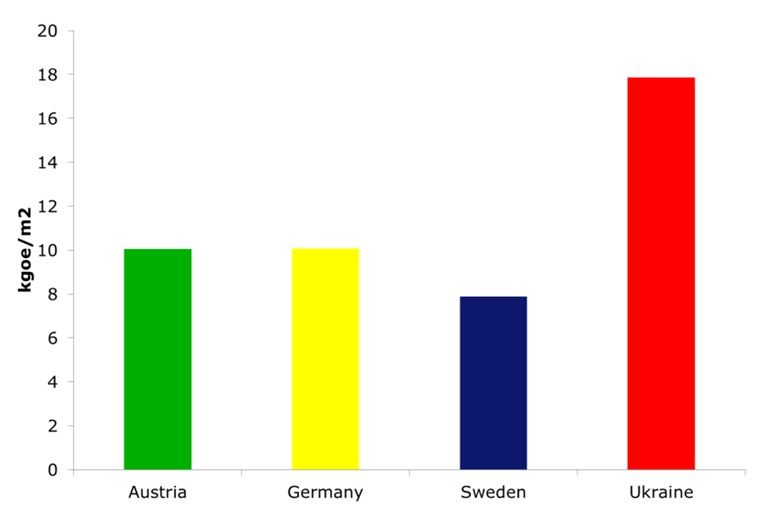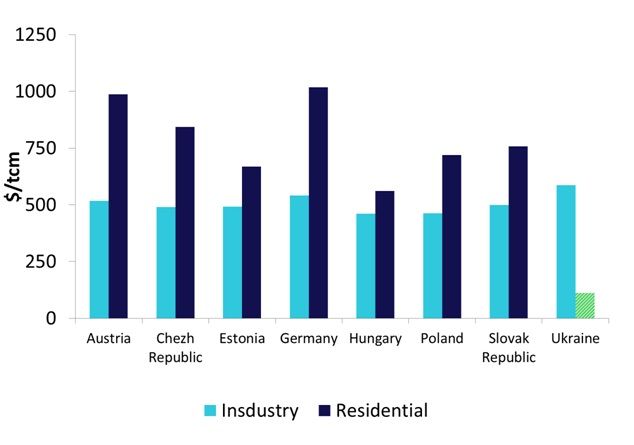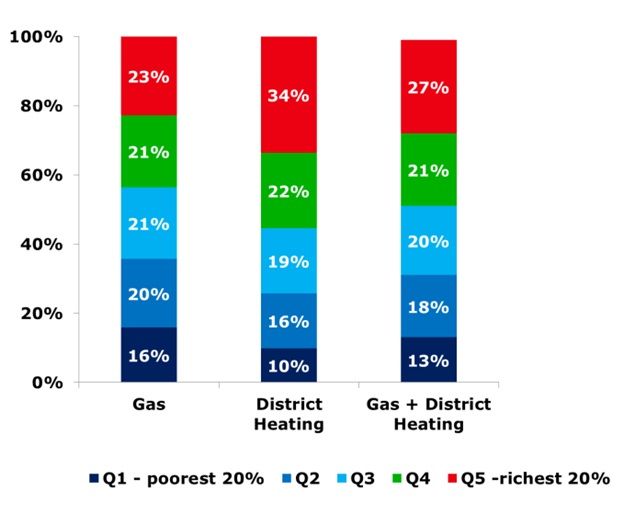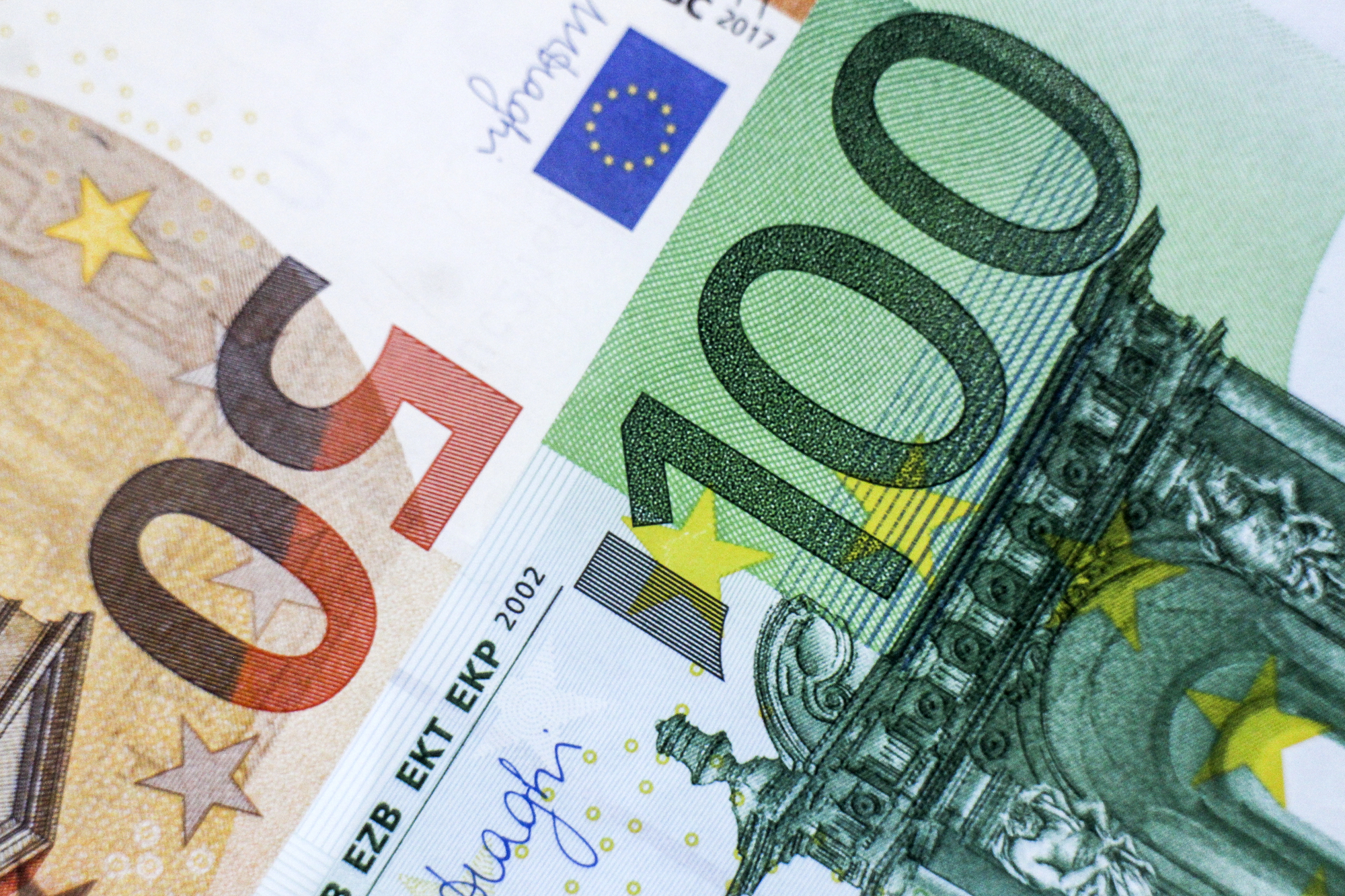Current economic crisis raises unprecedented energy sector reforms challenges before the Ukrainian government. The performance of the energy sector is unsustainable in Ukraine today. It is a root of the worst economic problems – twin deficits, depreciation of the national currency as well as pervasive corruption. At the same time, market transformation of the sector would enable Ukraine to realize huge untapped energy saving potential and increase energy independence, stimulate employment and return to sustainable growth. However, it will require the swift and often politically unpopular reforms such as abolishment of the price subsidies to the residential sector.
Unsustainable level of price subsidies
Currently, Ukrainian households pay less than 17% and 21% of the market price for natural gas and electricity respectively. Ukraine is a net gas importer and market price at the Ukrainian market is the price of imported gas. The price of natural gas sold to district heating (DH) companies for heat generation for residential consumers is linked to the average residential tariff and was also only 17% of the industrial price in January 2015. Figure 1 presents the prices for natural gas for industrial and residential consumers in Ukraine and the neighboring European countries at the end of 2014. All of these countries have a large share of Russian gas in their balances and their prices could serve as a good proxy of the market price for Ukraine. The price for industry is slightly higher in Ukraine than in European countries due to the discriminatory contract signed by Putin and Tymoshenko in 2009. At the same time the price for households is about 5 times lower in Ukraine than in Hungary, 6-7 times lower than in Czech or Slovak Republics or Poland. It is even nine times lower compared to residential prices in Austria and Germany.[1]
Figure 1. Residential and Industry Prices in the IV quarter 2013
Source: IEA Natural Gas Information 2014 and own estimates
In order to maintain so large gas and heat price subsidies to households the government has to provide huge direct and quasi-fiscal subsidies. Despite average natural gas price increase for residential consumers by 56% and district heating tariffs hike by 40% these subsidies amounted to 7% of the GDP in 2014. The deep devaluation of national currency almost eliminated the effect of gas and heat tariff increases as well as the reduction of the imported gas price and the total amount of price subsidies stayed almost the same level (7.5% of GDP in 2013). The fiscal burden of subsidized residential natural gas and district heating subsidies is huge. The government support of the cash-stripped Naftogaz was UAH110 bn in 2014 that is bigger than healthcare and education expenditures combined. The electricity price for households is cross-subsidized by other consumers – the difference between the residential price and the cost of electricity supplied to them is added to the wholesale electricity price and distributed among commercial users and budget organizations proportionally to their electricity consumption. Total amount of residential electricity price subsidies was UAH37.7 bn in 2013.
Consequences of price subsidies
The current system of price subsidies is extremely inefficient. It does not achieve its main objective – protection of the poor. Existing energy subsidies are regressive – richer and middle class households obtain much higher benefits from subsidized gas price. They live in larger apartments and use more gas and heating energy per household. The World Bank 2013 study[2] revealed that highest two quintiles obtain almost half of energy subsidies while lowest two quintiles obtain less than a third. Thus, 3.4% of GDP goes to subsidies for the people who probably do need them. The regressiveness of the subsidies is even larger if compare the amount of budget subsidies received by highest and lowest income quintiles. The richest households receive twice as much subsidies as the poorest – 27% and 13% respectively (see Figure 1).
Figure 2. Distribution of direct budgetary and quasi fiscal subsidies by income quintiles (2011)
Source: The World Bank, (2013), Ukraine Special Focus: Residential and District Heating Tariffs in Ukraine
Keeping residential natural gas and district heating tariffs well below cost-covering level have a negative impact on domestic gas exploration and extraction as well as leads to an excessive natural gas demand. International Energy Agency estimated that Ukraine may be self-sufficient in natural gas in a rather short time-span. The necessary conditions to attain this target are simultaneously facilitating the sufficient investments into upstream gas segment and boosting energy efficiency in order to reduce current demand. The current tariff system cannot allow meeting both of the above conditions:
- first, tariffs for natural gas for residential consumers do not allow covering even operational costs of Naftogaz. The expenses on exploration and drilling would require very large investments that cannot be generated without raising tariffs to cost-covering level;
- second, low prices on natural gas and district heating are the major barrier for investments in energy efficiency in residential sector. Ukrainian households consume on average two times more energy resources for heating and hot water per a square meter of a floor compared to the EU countries with a similar climate (see Figure 2). Ukrainian households consume about 44% more energy resources than in Germany and 56% more than in Sweden.
Moreover, the quality of the services (temperature in apartment or number of days of hot water supply per year) is substantially lower in Ukraine. In addition, the excessive demand for gas in residential sector leads to higher current account deficit which, in turn, creates additional devaluation pressure on the natural currency. Boosting energy efficiency in the residential sector up to the EU level would allow to cut the natural gas import by half and refuse from its import from Russia.
Subsidized tariffs on natural gas and heat for residential consumers do not allow attracting the required investments into outdated Soviet infrastructure as well as disincentivize consumers from energy saving. Thus, most boilers have heat losses 10-15% while average losses in the networks are about 17% and could be considerably higher and reach 40% for some DH companies. For comparison, in modern systems losses usually are below 10%. Boosting energy efficiency to European level should substantially reduce the welfare losses of households after tariffs increasing to cost-covering level and improve the environment by reducing greenhouse gases emission.
Figure 3. Residential energy consumption on heating and hot water supply per a square meter of a floor area in 2012, kilograms of oil equivalent (kgoe/m2)

Source: ODYSSEE, State Statistical Service of Ukraine and own estimates. Note: the consumption in the EU countries is adjusted to the structure of the building stock in Ukraine (percentage of DH and individual heating)
The different gas prices for residential and other customers lead to distortions at the gas market. Natural gas distribution and supply and district heating companies have the incentives to misreport gas consumption and district heat supply to the residential customers. The heating bill is based on the floor area of the apartment instead of actual gas consumption of households with individual heating or heat consumption of households connected to district heating. Thus, the companies may claim that the residential consumption higher that it actually is and underreport the consumption of the commercial and other customers. Eventually it leads to bigger losses of Naftogaz supplying gas below cost-covering level that have to be covered out of state coffers.
The subsidized gas and district heating prices are also the major obstacle in untapping the substantial renewables potential in Ukraine. Ukraine has large opportunities for the use of renewables and waste in the heating sector especially in biomass combustion from wood and agricultural waste. IEA cites the 2 Mtoe forest biomass potential and 12 Mtoe agricultural waste potential in Ukraine.[3] Thus, the total potential is equal to 14 Mtoe or about 17 bcm of natural gas. There are a number of fiscal incentives for renewable energy development but they have no effect so far on gas substitution by renewables. Although the costs of heat produced from biomass are noticeably lower than costs of heat produced from gas at market prices (by about 20-30%), any source of fuel cannot compete with highly subsidized gas for heat supply to residential customers.
Altogether, the elimination of price subsidies would allow to reach manifold benefits – improve macroeconomic stability, remove distortions, untapped energy saving potential, drastically cut gas consumption and guarantee energy security for Ukraine. The law on State Budget on 2015 stipulates the National Energy and Communal Utilities regulation Commission to increase tariffs in the first quarter but the new tariffs have not been disclosed yet.
Challenges in Tariff Reform
However, there are serious challenges for the instantaneous price subsidies elimination. First, the six times increase in residential natural gas tariffs and correspondent 3.6 times increase in district heating tariffs would cause huge welfare losses for households. The initial gains in terms of lower gas consumption will be moderate. The IMF estimates the price elasticity of residential natural gas demand at 0.26-0.28 depending on income group. Many rural households lack required financial resources for investments in energy efficiency. Most of the urban households live in the buildings built in Soviet times and do not have individual meter and the opportunity to regulate their consumption depending on outside temperature. The organization of the homeowners into the association in the multi-apartment buildings and taking the joint responsibility for building takes time and may be very problematic for the buildings with many retirees. Second, the current implicit quasi-fiscal subsidies would require the explicit financing out of the state budget. Almost 100% of the households would be eligible for the housing and utilities subsidies (HUS). Although the subsidies would be much more targeted they would be again universal. In addition, substantial number of households (more than 2.8 m) based on social and occupation criteria obtain privileged utility bills. Their discount may vary from 25% to 100% of the bill depending on the group. It should be mentioned that the HUS are much more progressive compared to utility privileges. The total required budget expenditures for subsidies and privileges financing would exceed the government support of the Naftogaz last year. The current social system is likely to collapse with the possible number of applications for subsidies. Currently, the same social inspector has to deal with both HUS and applications for assistance from the internally displaced persons.
On March 3, the National Energy and Communal Utilities Regulation Commission (NECURC), which regulates gas market including setting tariffs for different groups of consumers, made a serious decision towards elimination of the gas and DH price subsidies. According to adopted by the NECURC Decree, the households with individual heating will have to pay UAH3600 per 1tcm only for 200 cm/month during the heating season. For all other gas used for heating the households will pay UAH7187/tcm. The same tariff will apply for all other customers using gas for cooking and water heating during the whole year. Thus, the average tariff was increased from UAH1309/tcm to UAH5040/tcm or by 285%. The gas tariff increase for DH companies is less moderate – from UAH1309/tcm to UAH2934/tcm which translates into 71.8% residential DH tariff increase.
The major reason for delay is probably caused by the low level of building heating meters installation (only 36% in the middle of 2014). According to leaked agreement with the IMF, the price for DH companies will reach 75% of the imported gas price parity along with planned large acceleration of meters installation the next year and will be set at 100% of the imported gas price parity in 2017. Thus, the government plans completely eliminating gas and DH price subsidies in 2017.
In addition to gas and DH tariff increases, the NECURC adopted a schedule of electricity cross-subsidies elimination by 2017. The average price for households will increase 3.5 times during the next two years (from UAH0.36/kWh to UAH1.28/kWh). I would like to stress that even this price would not likely to cover the complete LRMC of electricity supply to residential customers. It will be still 2.8 times lower than an average price for the OECD countries while transmission and distribution losses are much larger in Ukraine.
The above scheme of gas and electricity tariff increases has serious drawbacks. First, the devaluation of hryvnia may eliminate all positive effect of the price increases. It is unclear whether the NECURC will further adjust the prices along with devaluation. The hryvnia fell on interbank exchange to 33.5/USD on February, 24 but the exchange rate returned to about 23.0/USD on March 6. Thus, the new price of gas for DH companies will be only USD128/tcm at current exchange rate which is lower than it was at the beginning of 2014 before its first increase – USD164/tcm.
Second, the government is going to delink again the natural gas price for households and DH companies. These prices were equated only last year and their delinkage may lead to market distortions, in particular incentivize consumers with inefficient heating system choice. The electricity price increase is very small compared to actual LRCM of electricity supply. Thus, the population may misinterpret price signals and switch to individual electrical heating systems while either autonomous or district heating would be more effective choice of heating.
Finally, the last issues I would like to stress are the urgency of the social protection (SP) system reform and legislative changes for energy efficiency improvement. This year the government reserved UAH24.4 bn for the HUS and privileges transfers. This amount should be enough to cover the required expenditures since major bill increases will be applicable only for October-December. However, in 2016-2017 after the enforcement of scheduled increases the required compensation out of state coffers for privileges and subsidies may increase to 5-7% of GDP. This amount is unsustainable for any social protection. As was mentioned above the current system is highly regressive and the task is to change it to ensure the protection of the most vulnerable people and guarantee the affordability of heat and gas to this group. The new effective SP should combine all of the existing programs and be linked to the minimum household income providing social protection in a form of money transfers only to the poor people. In addition, the government and the parliament should combine their efforts on adoption of the legislation aimed at attracting financing in energy efficiency improvement (Law on Energy Efficiency in Buildings, Law on Homeowners Association etc). It would allow increasing energy efficiency and lowering the residential consumption and correspondently their energy bills.
To sum up, the residential energy tariff increases is imminent if Ukraine wants to return to the sustainable growth path. It is a necessary step to boost domestic production and reduce inefficient demand in residential sector and guarantee energy independence. Other important consequences are improvement of current account, elimination of serious market distortions, reduction of corruption and the development of renewable energy. The improvement of energy efficiency and effective social protection would allow substantially mitigating the impact of tariff increases and keeping energy affordable to the most vulnerable people. The optimal tariff increases should take into account the correspondent increases in budget expenditures and the ability of the social protection to meet the increased demand for social assistance. At the same time, the possible delinkage of gas, heat and electricity tariffs may send the wrong price signals for consumers resulting in inefficient heating system choice.
Notes
[1] The difference in industrial and residential prices are attributed to the much higher distribution and supply costs for latter than for former.
[2] The World Bank, (2013), Ukraine Special Focus: Residential and District Heating Tariffs in Ukraine
[3] IEA Energy Policy Review of Ukraine 2012, IEA/OECD, Paris, France
Attention
The author doesn`t work for, consult to, own shares in or receive funding from any company or organization that would benefit from this article, and have no relevant affiliations





